EPISODE 5: BALTIMORE TO HARPERS FERRY
Here are a couple of signs from the road, the first from outside Baltimore and the second from Greenbelt, MD. The second reminds me of the Marx Brothers routine, I think from Animal Crackers, where Groucho is dictating a letter to Zeppo and addressing it to the law firm of Hungadunga, Hungadunga, Hungadunga, and McCormic.
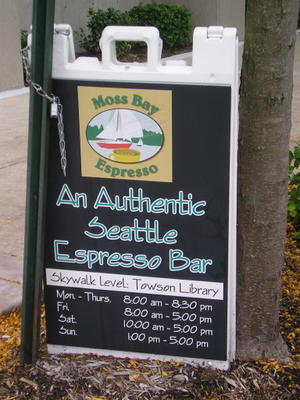
Seattle Coffee?
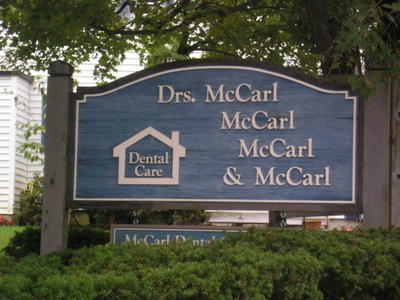
One for each wisdom tooth
The main reason I went to Baltimore was to visit Ray Geddes, another of the 501st paratroop infantry regiment. Although Ray was not standing right with my father when he was killed, he did know him and has turned out to be my best friend of all the old veterans. When I met him at the first reunion I attended he told me then that he was afraid of my father. I have seen him at several subsequent reunions and I have visited him and his wife Shirley a couple of times before in Baltimore. Also, Ray arranged a reunion of just G Company (not the entire regiments) in Baltimore in 2002. It was a great occasion where my kids were able to attend and meet Ray, Walter Turk, Don Kane who we are about to meet, Jack Urbank and Warren Purcell. Urbank and Purcell have died within the last year. Purcell was still able to get into his army uniform. None of the men travel anymore, hence this journey of mine to see them at their homes.
Here is part of the picture from Camp Mackall again. Ray is standing in the first row, four men to the right (our right) of the man standing behind my father.
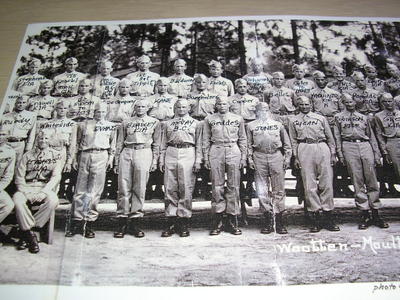
Ray at Camp Mackall
Ray’s fighting time was relatively short. He was at Pouppeville but was not near my father. However he was very close to a memorable incident where a man got shot and Eddie Hohl, a medic, went up to take care of him. Hohl was shot by a German as he ministered to the man, an egregious incident. Hohl was buried in the same temporary plot as my dad, in the courtyard of the house that was formerly used as the German headquarters.
Two days later in a famous encounter at what later became known as Dead Man’s Corner, Ray lost the sight in his left eye when it was penetrated by a piece of shrapnel the size of a finger nail. Urbank told me last year that he was standing next to Ray and the vitreous humor spilled on him. So that was the end of Ray’s time with the airborne as he was sent back to the states to recover.
He met Shirley when he was a MP in Baltimore as he finished out his military duty stateside. She was a western union operator in a RR station that Ray was patrolling. That building is now an historical monument, maybe because that is where Ray and Shirley met, but maybe because it has something to do with Lincoln stopping there on his way to the White House. Ray is not sure.
We had a great visit and it was not hard to get Ray to talk on tape for a couple of hours.
Shirley is an avid bird watcher and a great cooker of soft shell crabs, which we had for, lunch. Ray is an avid gun collector, mainly of civil war vintage firearms. I was also able to meet one of their sons who was in town; he is an economist in Cornell’s policy program and has just finished a year’s stint with the Council of Economic Advisors.
In this picture Shirley is holding the recent book by Jerry McLaughlin that features men of Company G, and my little write up of the Pouppeville action in the appendix. Ray is holding a book on Utah Beach by an historian that lives very near Ray- it includes a quote by Ray about the Eddie Hohl incident.
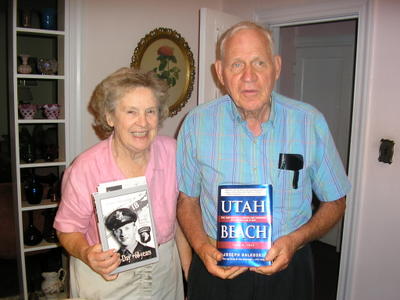
Ray and Shirley
On to DC. These next photos are of one of my favorite places in the capitol: a row of Georgian row houses that are used as executive offices on Lafayette Park, kitty-corner from the white house. The was a proposal to tear these buildings down and build a new executive office building on the site but first lady Jackie Kennedy stopped this nonsense and had them preserved. The close up is of the Council on Environmental Quality office. The most “high profile” project I ever worked on when I was with a planning firm in Berkeley in the 1970s was when we were a subcontractor on a project funded by the CEQ – I think it was to evaluate the urban growth impacts of a Sacramento waster water treatment plant but don’t really recall. What I do recall is getting a trip to DC, meeting in this office building, and then later meeting with the CEQ project director in her home in Georgetown and meeting her nephew Seymour Hersh who had just cracked a big story on assassination attempts on foreign leaders or something.
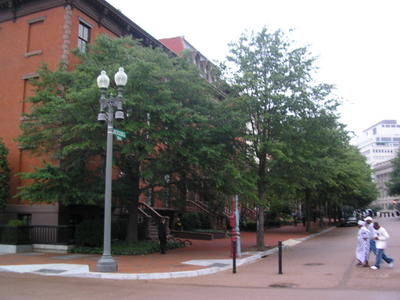
By Lafayette Park
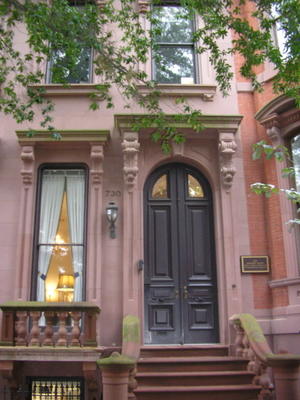
Council on Environmental Quality
I didn’t even bother taking a picture of the White House. There was a time when that building meant a lot to me but not now. I was not really angry or upset – it just made me feel rather sad and empty.
On to the main reason for coming to DC – the new World War II memorial. It has a very controversial history. It’s location and architecture were large bones of contention. I did not feel that it detracted all that much from the open area between the Lincoln Memorial and the Washington Monument since most of the memorial is sunken below ground level. But I think the critics that have said it looks like fascist architecture and could have been designed by Hitler’s architect are probably right. But mainly it just left me rather cold. Especially as compared to the Vietnam Memorial which has turned out to be such a humane achievement.
These pictures feature references to Normandy and D-Day, which are important to me, of course. Also, there are pictures of two scenes, which seem obligatory in recent memorials since the Vietnam Memorial received such criticism for not featuring human figures – I think that criticism was wrong. Anyway, the first scene shows a jumpmaster (like Lt. Marks and his men, like Turk, Orlowski, and Geddes); then a scene of the fallen. Following is a picture of the wall of gold stars, one for each 100 men who were killed in action. The last picture was taken at the visitor kiosk where one can look up on a computer screen the names of men who were killed in action.
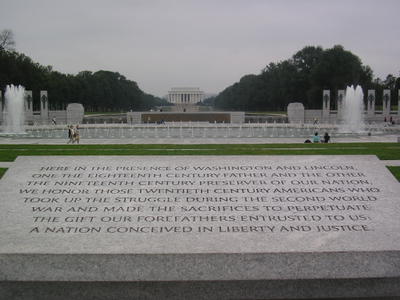
WWII Memorial 1
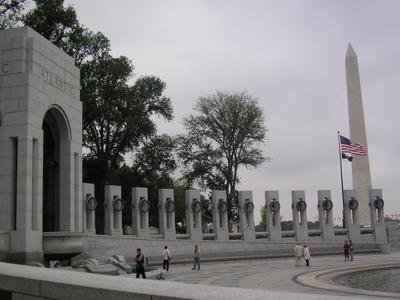
WWII Memorial 2
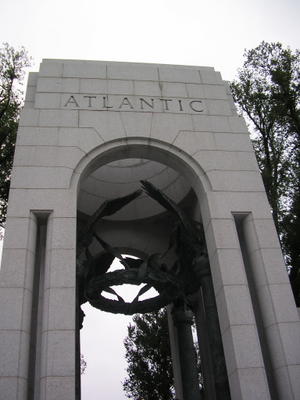
Atlantic Theater
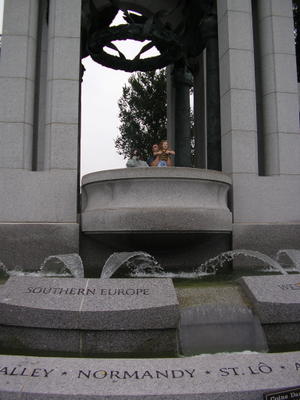
Normandy
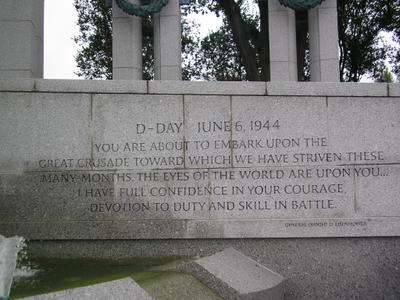
Ike’s D-Day letter to the troops
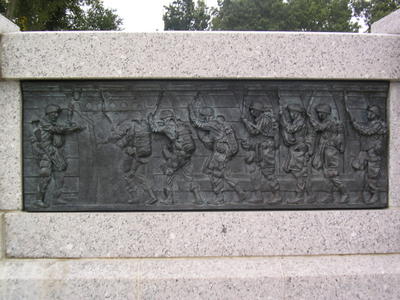
Jumpmaster and troops
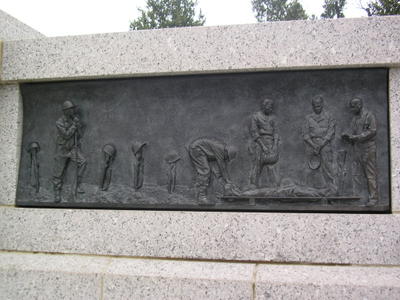
The Fallen
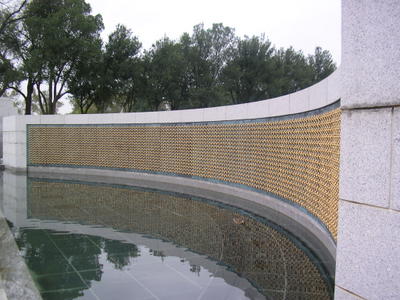
Gold Stars
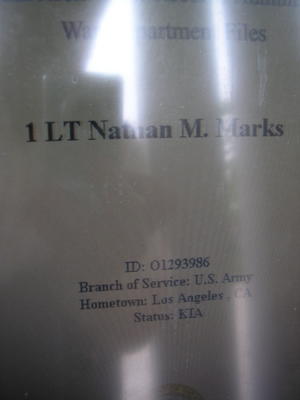
Lt. Marks KIA
Here is the new Indian Museum in DC. It was interesting in the respect that they tried to have Indians themselves be the curators and designers instead of other “outsiders”. It covers all of the Americas. I thought the lay out of some of the exhibits was a bit confusing and the displays could have even been stronger with respect to the genocide perpetrated against Native Americans. They have good Indian food (not Curry) from different regions in the Americas.
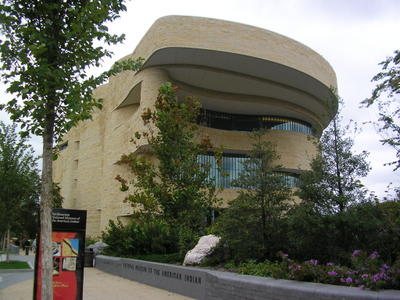
Where's the Casino?
Speaking of Indians, here is a picture of the Marine Memorial at Arlington Cemetery. One of the flag raisers was Ira Hayes who could not deal with the fame from being one of the flag raisers. He died in a drunken stupor in the freezing snow back home in New Mexico or Arizona. The main reason I took this picture is to mention probably the best book by a child of a WWII veteran, Flags of Our Fathers by James Bradley. He notes that half of the flag raisers never made it off of Iwo Jima alive. His father was one that survived but never considered himself a hero. He felt that the men that died there were the heroes.
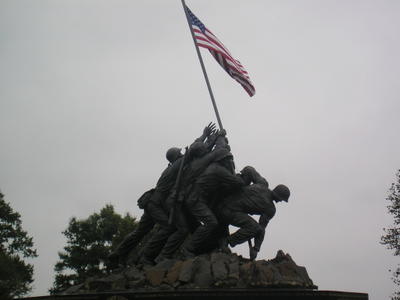
Iwo Jima
Then down the road a bit on the main drive leading to the National Cemetery is a memorial to the 101st Airborne Division (the 501st Paratroop Infantry Regimen was part of the 101st in WWII). Note the inscription on the back, showing the people who sponsored this monument; it includes Julian Ewell. I think I mentioned that he led the attack on Pouppeville. He put his head around the corner of a building and was also hit by a German sniper. But instead of getting killed as my father, he was only hit in the helmet. Ewell went on to have a long career in the military and is still alive today. Such are the fortunes of war. What a difference two inches can make. I may have told this story before.
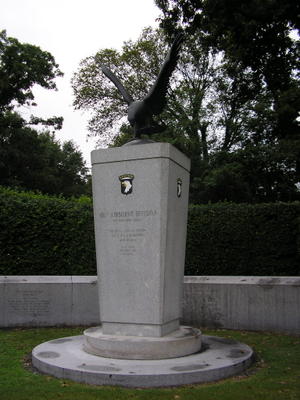
101st monument
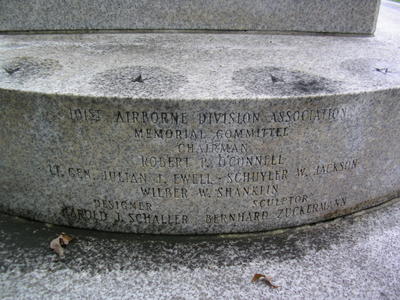
Ewell
When I go to DC I usually pay my respects to Jack and Bobby here at Arlington. I think the architect who designed JFK’s gravesite was the Kennedy family favorite, John Carl Warneke. I think he did a good job although most of his stuff in California is not much to write home about, at least that is what I thought when I was in the first group to live in one of the dorms he designed at Berkeley.

JFK
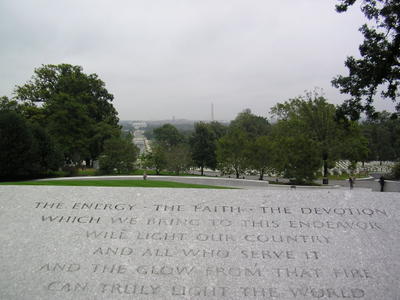
Glow from that fire
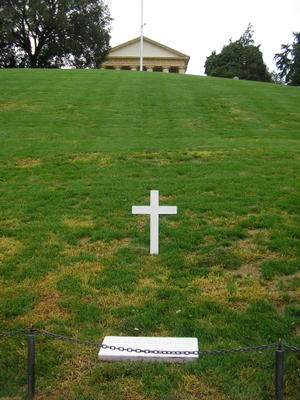
Bobby
Greenbelt vs. Tyson Corner In the DC area I stayed in campgrounds both near Greenbelt, MD and Reston, VA – both new towns of a different era. Reston is near Tyson Corner and it is hard to imagine two different types of places with different types of people as Tyson Corner and Greenbelt – at least the “old” Greenbelt I saw. Here is a picture of the town center that was built by the federal government in the 1930s as one of three new towns, art deco and all:
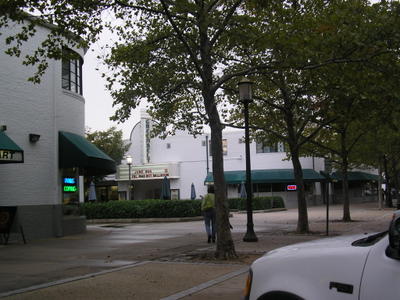
Greenbelt, Md
In Greenbelt I came to have breakfast at the New Deal Café because they have a wi-fi hot spot there where I could use my laptop for email and blog entering. It was quite a scene, a throwback to the New Deal era or at least some island of counter-culture. I will try to paint a verbal picture of the scene. Most of the staff seemed to be developmentally disabled. This slows down the food ordering process quite a bit. I think there must be some assisted-living situation nearby. I saw an old guy with a stroke and one arm hanging down. Also, a chubby middle-aged guy with a short grey goatee, wearing a black t-shirt and faded jeans and white tennis shoes, is talking about Brazilian music with a young Brazilian mother. But mainly he is carrying on about the ACLU defending the right of people to have sex in public in Oregon as a matter of free speech. He says he is a liberal but this is too much. He says they would also defend the Minutemen guarding our border against immigrants. He says their new acronym should be American Criminal Law Association. Before he eats he says grace: “Jesus, Buddha, Allah - ruba dub dub god bless this grub – that should take care of it.” The owner is a woman with grey hair; she looks like she lives in Berkeley. Another man is talking with a heavyset woman with red hair - she is a grand mother but does not seem all there. In any case, this seems a world away from Tyson Corner, which is like 12 Bellevues lumped together. I went to a mall there because I heard on the radio that they had an LL Bean store and I left my favorite LL Bean shirt in a motel in Winnipeg, I think. First I went to the wrong mall – then I found the store in the bigger (I mean VERY big) mall. The whole place is an amazing sea of commercialism. I did buy a shirt (not the one I lost which was not in stock) but got out as soon as I could. All this by way of showing what differences there are in this country.
After leaving DC I headed up to Purcellville, VA to see Don Kane, the last of the men from my dad’s unit that I will visit on this trip. Don does not remember my father but I have met him a few times at reunions and we have gotten along very well. I also had some nice discussions with his wife, Sue, who died earlier this year. She was a planning commissioner in the area and worked hard to preserve historic buildings and wildlife areas. In a really nice gesture they have named a wild life sanctuary after her.

Sue Kane Nature Preserve
In probably the biggest oversight so far, I forgot to take a picture of Don but will try to rectify that somehow. The main thing that I want to note about Don is his amazing story on D-Day; this shows the fortunes of war as the story about Ewell, above. My father and the other officers did not fraternize with the enlisted men but he had a drinking buddy, 2nd Lt. Crouch, that he stayed with in Lambourn, England while the others went off to London. Most of the men I have met did not like Crouch. Anyway, as they were about to get on the planes and head for Normandy Crouch decided he wanted to be on the same plane as his Sgt. so he kicks Don Kane off the plane. Don is angry for being separated from his buddies. But the plane that Crouch got on is shot down and explodes over Normandy. He is buried in the cemetery at Normandy and Don is still alive to this day.
So that ends my series of visits with men who served under my father. I feel very grateful that I have been able to meet and become friends with these men over the past few years. It is a real blessing.
After visiting Don I drove to Winchester VA, and Charles Town and Harpers Ferry West Virginia. The following pictures show Patsy Cline’s home in Winchester, the former James Wood high school (now middle school) where Patsy may or may not have gone but where Dennis Meier went for sure, the worlds largest apple with an “apple on parade” in the background – everybody is doing this fund raising idea it seems, and finally the main street turned into a pedestrian zone. As with other attempts at pedestrian-only areas it does not really seem to work as they are usually under utilized. Although we like to deemphasize the car, if cars are removed completely these areas often become out-of-sight out-of-mind and are not used much. A comparison in my mind with the huge amount of “pedestrian” activity in the malls – after driving there - in Tyson Corner really struck me.
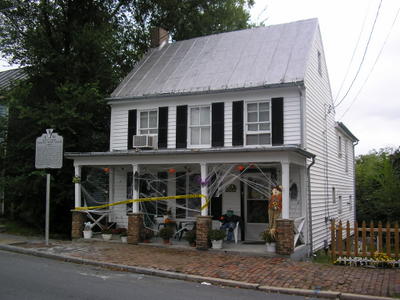
Patsy Cline's home
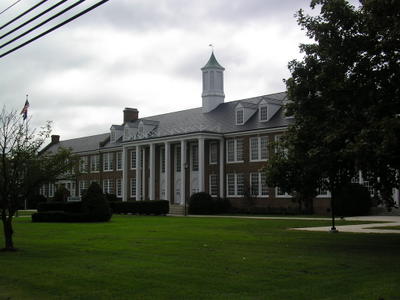
James Wood High
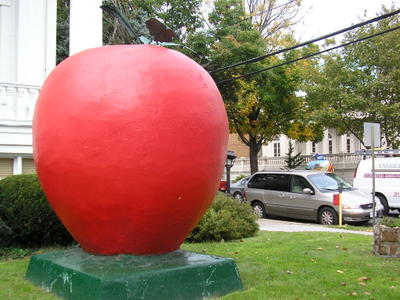
World's Largest Apple
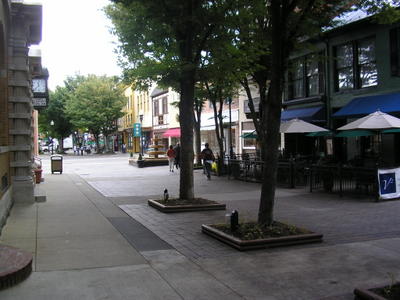
Pedestrian zone in Winchester
On to Charles Town in West Virginia. Here are pictures of the courthouse where John Brown was convicted; he was hung a few blocks south on George St. Then there is a picture of an estate (Happy Retreat) in the same town owned by George Washington’s brother and where Dennis Meier used to play.
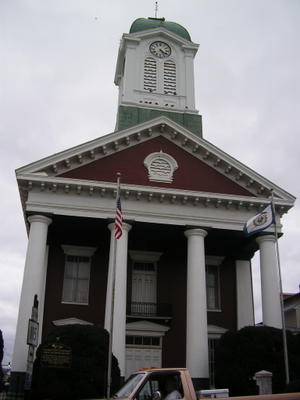
Charles Town Courthouse
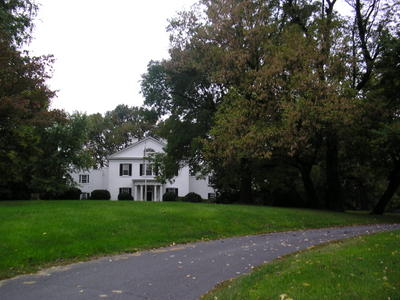
Happy Retreat
And here is one of the armory buildings located up the road in Harpers Ferry which John Brown attacked and where he was captured. The building now stands a few yards from its original location. It had been taken down and shipped to Chicago for the Columbia Exposition in the early 1890s. Make no little plans. Eventually it was returned to Harper’s Ferry in close to the original place.
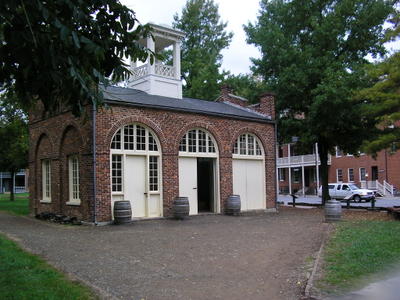
Armory building in Harpers Ferry

0 Comments:
Post a Comment
<< Home